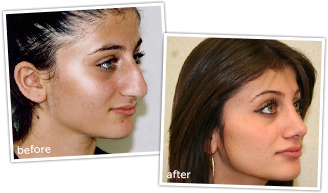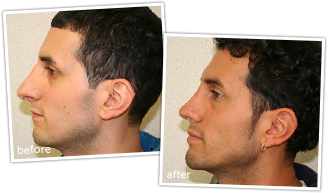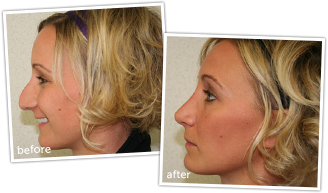Rhinoplasty Chicago
- Introduction
- What Rhinoplasty Can Accomplish
- Who Is a Candidate for Rhinoplasty?
- Rhinoplasty Procedure Details
- Ethnic Rhinoplasty
- Recovering from Rhinoplasty
- Rhinoplasty Costs
Introduction
Rhinoplasty, or nose shaping, is probably one of the most difficult and technically demanding operations in cosmetic plastic surgery. Because the nose occupies the central and most projecting part of the face, any minor flaws can be noticed, especially with a critical eye. Knowledge of facial anatomy and proportion as well as artistic vision, surgical skill and experience are all of paramount importance in achieving excellent results.
Dr. Gikas has the above qualities as well as a commitment to outstanding results, attention to detail and a zeal for perfection. He strives for natural-looking results in his Chicago rhinoplasty patients while placing patient safety and comfort as top priorities.
Dr. Gikas performs most of his surgeries in a hospital setting, where patients benefit from the skills of board-certified anesthesiologists for anesthesia, as well as highly trained nurses and assistants.
What Rhinoplasty Can Accomplish
Rhinoplasty can be performed to improve the appearance of the nose or to correct a structural deformity (e.g., deviated septum) that interferes with normal breathing function.
Who Is a Candidate for Rhinoplasty?
Rhinoplasty candidates are individuals who are uncomfortable with the appearance of their nose or who have a structural deformity that impairs their breathing.
Learn more about rhinoplasty candidates.
Rhinoplasty Procedure Details
Depending on the rhinoplasty patient’s needs and preference, either general or intravenous sedation with local anesthesia is used during surgery. A board-certified anesthesiologist who is highly trained and experienced will administer the anesthesia and monitor the patient until he or she returns home after the procedure.
Dr. Gikas performs either an open or closed rhinoplasty depending on the individual patient’s needs. With the open technique, he makes a small incision across the narrowest part of the skin bridge between the nostrils (called the columella), and places the rest of the incisions inside the nose. Dr. Gikas uses this technique in cases that are more complicated and/or the nose needs a lot of tip refinement and structural support. He also uses the open technique in secondary or revision rhinoplasties.
With the closed technique, Dr. Gikas limits the incisions to the inside of the nose. He uses the closed technique in cases where minimal tip or bridge work is needed, and sometimes in minor secondary revisions.
After making the incisions, Dr. Gikas may make alterations to any number of internal nasal structures, including the tip, bridge, nasal wall, nostrils and septum. He will build and shape the framework and skeleton of the nose (i.e., the cartilage and bones) in a way that allows the skin to drape over it and show all the details of the surgery. Dr. Gikas may need to thin the skin in patients with thick skin in order to better visualize the details of the sculpted nose when it heals. Attention to detail is critical in rhinoplastic surgery, and every attempt is made to achieve the best possible result and avoid future revisions.
About 5 to 7 percent of all patients require revision, but this is usually minor (e.g., adjusting nostril width or tip rotation). Dr. Gikas corrects these issues with local anesthesia in his office, at no additional cost to the patient.
After Dr. Gikas has sculpted the nose to the desired shape and closed all incisions, he will place tape and a plastic splint over the bridge of the nose, with small tubes in the nostrils for breathing. The splint and tubes are removed after a week. The new nasal shape will be almost immediately evident, except for some swelling, which mostly subsides over several weeks. It may take up to a year for the final nasal shape to be revealed.
Ethnic Rhinoplasty
Dr. Gikas is particularly skilled and talented with ethnic rhinoplasty procedures. When designing a plan for ethnic rhinoplasty, Dr. Gikas takes into consideration the ethnic concepts of beauty and facial balance and harmony, as well as the desires of the patient.
African American Rhinoplasty
Characteristics of a traditional African American nose include the following:
- Wider and lower bridge
- A bulbous, wide tip
- Flared nostrils
- Wider base of the nose
- Decreased nasal length and height
- An acute angle between the upper lip and columella
- Thick skin
Dr. Gikas uses the open technique to accurately assess the anatomy of the nose and to precisely and effectively correct the deformity. He also uses suturing and cartilage grafting on the nasal tip and bridge; he can harvest cartilage from the septum, ear and rib, if need be. Dr. Gikas can augment the nasal bridge to increase height and create a nasal pyramid, along with narrowing of the nasal bones to create a dramatic change. He can also alter the projection and contour of the tip with cartilage as well as sutures; this reduces some of the flaring of the nostrils. Dr. Gikas may carefully remove excess fatty tissue in noses with thicker skin.
After closing the incisions, Dr. Gikas can further correct flared nostrils and narrow the base of the nose by carefully excising wedges of skin from the junction of the nostrils to the upper lip. This may be deferred to a later time when swelling subsides, allowing Dr. Gikas to be more precise. This final step can be performed in the office with local anesthetic.
Post-operative swelling can last longer for African American patients, but this can be controlled with serial splinting and taping, or even local steroid injections.
Middle Eastern Rhinoplasty
Middle Eastern rhinoplasty is a uniquely challenging operation that requires knowledge of appropriate and precise techniques, as well as experience, to achieve an excellent outcome. It also involves a long period of healing.
Characteristics of a traditional Middle Eastern nose include the following:
- Thick skin with fibrofatty tissue, especially around the tip area
- Notable, often large hump on the bridge of the nose
- Crookedness
- Droopy and often bulbous tip with no definition
- Very active nasal tip muscles with greater tip droopiness when smiling
- Malpositioned alar cartilages
- Nostril tip imbalance and asymmetry of the nostrils
During the initial consultation, it is critical to outline all the problems associated with the patient’s nasal anatomy and to assess the patient’s expectations and set realistic goals.
As with African American rhinoplasty, Dr. Gikas uses the open technique and addresses every component of the nose, including the dorsal hump, nasal walls, alar cartilage and the tip. He may graft cartilage from the septum or ear to provide tip support and definition. He will address tip rotation and the muscles that depress the tip when the patient smiles. Dr. Gikas will carefully remove the fibrofatty tissue under the skin around the tip area to provide definition of the sculpted tip, and he will address any flaring of the nostrils and asymmetrical elements to provide balance to the overall nasal structure.
The vast majority of Dr. Gikas’s Middle Eastern rhinoplasty patients are very happy with their surgical outcomes, as they notice a dramatic improvement in their appearance.
Asian Rhinoplasty
Dr. Gikas has found that Asian rhinoplasty patients have different goals than patients of other ethnicities. He aims to achieve a refined and natural look that is balanced and matches the rest of the patient’s features.
Characteristics of the traditional Asian nose include the following:
- Low, deficient and wide nasal bridge
- Poorly defined tip with lack of projection
- Weak or deficient cartilage
- Thick skin (usually)
Typically, Dr. Gikas’s surgical goals for his Asian rhinoplasty patients are to provide tip projection and support and augment the bridge of the nose for a more aesthetically pleasing result.
As with African American and Middle Eastern rhinoplasty cases, he will use an open approach to surgery. He may harvest cartilage from the septum to use for tip projection and support. Dr. Gikas may use additional cartilage and suturing techniques for better definition. After assessing the tip projection, Dr. Gikas will augment the nasal bridge with cartilage grafts to achieve a harmonious balance with the forehead and upper lip. Occasionally, he must break the nasal bones to narrow a wide bridge.
Recovering from Rhinoplasty
For the first 24 hours after surgery, the face may feel puffy and the nose may ache. Headaches and swelling/bruising around the eyes are also common. Dr. Gikas will remove any packing within two days and the splint within a week. Although everyone recovers at a different pace, most patients return to work or school a week after surgery.
Rhinoplasty Costs
Rhinoplasty cost varies, based on the specific procedure and the patient’s unique needs. For more detailed information about the cost of rhinoplasty, please contact our office.
Schedule a Rhinoplasty Consultation
If you’d like to learn more about nose reshaping surgery and how it can help improve your appearance and confidence, please contact Chicago rhinoplasty surgeon Elias Gikas at (773) 878-6525.



